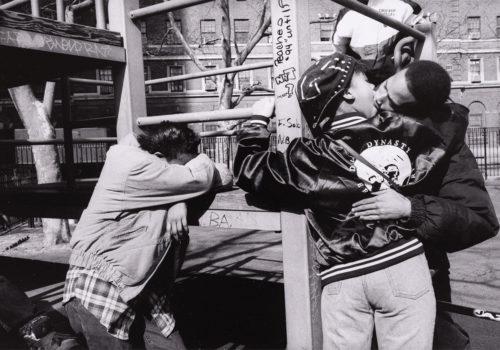The Galerie Rouge presents a personal exhibition by photographer and videographer Martine Barrat. “Soul of the city” its theme is one of the main subjects of her work: New York and its inhabitants. Arriving in this city in 1968, Martine Barrat quickly filmed and then photographed people she encountered in the Bronx and Harlem neighborhoods. Her gaze, far from being solely documentary, is driven by a total commitment to the people she photographs and whose daily lives she often shares – the participatory and collective aspect being a fundamental dimension of her work. Each scene, person or gesture recorded on film is a celebration of life and human relationships. The street, its rules and its ways of life, become under the gaze of Martine Barrat a world in its own right, joyful and serious at the same time, made of struggles and happiness, which we want to explore. An artist with multiple lives, Martine Barrat has always claimed great independence in her life as in her work. The exhibition is structured around different series and points of view on New York.
South Bronx
A selection of her early photographs of the South Bronx from the 1970s is first presented. At the beginning of the 1970s, Martine Barrat began to film gang members in the Bronx, a neighborhood completely abandoned by the municipality of New York, in a collaborative and participatory manner. In 1976, when her camera was stolen from her home by a neighbor, the leader of the Roman Kings gang, Pearl, gave her, her first still camera. She began to photograph close-up, in an almost cinematographic way, the bodies and gestures of the neighborhood’s inhabitants. Rather than photographing the poverty and violence that existed in the South Bronx, Martine Barrat highlighted the beauty of its inhabitants, the love that unites couples, the joy of children playing and looking for freshness during heatwaves in often dilapidated streets.
Harlem in my Heart
Street scenes and scenes of life in Harlem extend the exhibition. From the 1980s, fascinated by the African-American neighborhood of Harlem, Barrat photographed domino players, musicians from Blues and Jazz clubs, block party breakers (“neighborhood parties”) at the beginning of the cultural and musical revolution represented by hip-hop.
The second room of the gallery presents a focus on the women of Harlem, relatives and friends of Martine Barrat, including Love and Mabel, two major figures in her work and life of whom she made powerful, luminous and facetious portraits.
About Love, Martine Barrat writes: “Love was a very dear friend whom I photographed for many years. She was loved and admired by so many people in Harlem. When she walked down the street, she would stop cars because she was so beautiful. She is also one of two women admitted to the Rhythm Club, a place where musicians meet day and night to play cards on 143rd Street. All the musicians were so happy when she came.”
Do or Die
Finally, the last part of this exhibition is dedicated to her Do or Die series devoted to the clubs that train young boxers in Harlem, Bed-Stuy and the Bronx. This series, noticed at the time by director Martin Scorcese and photographer Gordon Parks, propelled Martine onto the international scene. Far from representing a world of toxic masculinity, Martine Barrat photographs boxing as a fraternal rite where tenderness and adversity meet.
Martin Scorsese wrote in the preface to the book Martine Barrat, Do or Die:
Astonishing, beautiful and disturbing. This is my first feeling when I see these images. Photos of poor neighborhoods provide the background – devastated streets, a state of desolation, landscapes of a virtual war zone highlighting above all the tiny chances, not of life or success, but of simple survival.
Of a six-year-old Puerto Rican boy, Carlos, preparing for battle, she writes: “His eyes pierced my heart. » We see it in her photos – the look of these young boys reflects hope, that of breaking everything around them in order to stay alive. These photos also reflect a threat – a tool necessary for survival and which must be cultivated. This is precisely what boxing allows.
The scenes in the locker rooms resemble religious rites: fighters preparing for sacrifice or redemption, boxers jumping rope in front of the mirror in a martyr’s posture. Two young boys standing in the ring, gloved hands on their hearts just before fighting, remind me how much society approves of this spectacle of struggle and suffering, provided that there are rules and ceremonials to soften its natural bitterness.
These are sumptuous and powerful photos. Regardless of how you feel about them, they show the one sad truth of survival: have rage, cultivate it, and fight your way out of it. So what did you expect?
Martin Scorsese
Preface to the book Martine Barrat, Do or Die, United States, Viking press, 1991
Martine Barrat : Soul of the city
May 24 – September 7, 2024
Opening reception on Friday May 24 from 6 p.m.
La Galerie Rouge
3 rue du Pont Louis-Philippe
75004 Paris
01 42 77 38 24
www.lagalerierouge.paris
Wednesday to Saturday from 11 a.m. to 7 p.m.
















